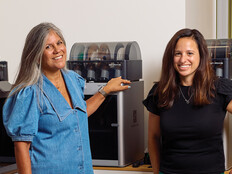What Gartner’s Top Tech Trends for 2019 Mean for Education
Augmented data analysis, blended digital tools and connected networks will reign among technology innovations in the coming year, according to IT analyst group Gartner’s top 10 tech trends of 2019.
“The top ten digital technology trends are all about building the intelligent digital mesh,” says David W. Cearley, distinguished vice president and analyst for Gartner. “It’s the convergence of all of this and using it to support a continuous innovation process.”
School districts have already seen some of these tools enter the educational space, with innovations such as AI-enabled teaching assistant programs and advanced data collection and analysis to improve student assessments.
As K–12 schools continue their E-rate processes for 2019, districts should be considering what tools are worth investing in to provide their students with the best outcomes in the coming year.
Artificial Intelligence Will Augment Data-Driven Initiatives
Analysts expect machine learning to play an important role in 2019, offering support for tasks that may require more time, energy and training than teachers and administrators have at their disposal.
- Autonomous Machines: Gartner predicts AI-enabled machines will be more common in 2019 as the technology advances and becomes commercially available. While autonomous school buses may be far down the road, companies like RobotLAB are already designing interactive learning experiences that incorporate autonomous machines to teach programming.
- Augmented Analytics: Teachers rely on data analysis to improve their relationship with students, especially as personalized learning programs become more widely adopted. Data collection and analysis has lead to innovations in student assessment design, helping educators pinpoint where students are struggling and adjusting coursework to supplement those areas. Augmented analytics will help take some of the burden off teachers who may not be trained in data analytics by using AI to take the brunt of the work instead.
New Tools Blend the Digital and Physical Worlds
Digital transformation in schools is already happening at a rapid rate, and there seems to be no sign of slowing down. Analysts predict the line between the real and digital worlds will continue to blur as current technologies advance and new tools are developed.
- Digital Twins: This concept is not new. Members of the online community maintain multiple versions of themselves through social media sites, online profiles and other means. Systems such as power plants have digital copies, mirroring the real thing, to monitor daily functions. This technology could be used in conjunction with tools like digital backpacks — longitudinal, interoperable student records — to analyze how individual students learn and to create more effective personalized learning curricula.
- Empowered Edge: Edge computing takes information processing and brings it closer to the source by using edge devices instead of sending information directly to and from a centralized cloud. The next iteration, empowered edge, will use AI to diversify the kinds of devices able to act as edge endpoints, such as displays or smartphones. This could prove crucial for K–12 schools that require more computing power as they integrate new tools like augmented and virtual reality headsets or connected classroom devices.
- Immersive Technologies: Speaking of AR and VR, the use of immersive technology is expected to rise as hardware and software continue to improve. According to Gartner, by 2022, 70 percent of organizations will experiment with immersive technology. With 5G on the horizon promising lower latency and more robust connectivity, the quality of these tools will continue to grow, expanding their potential to supplement K–12 education.
Improvements in Mesh Mean a Focus on How Users Engage with Tech
Schools are swiftly replacing older equipment with their next-generation versions. Previously, chalkboards were a natural part of most classrooms; today, interactive whiteboards reign. As this transition continues, K–12 schools will need to be mindful of how they design their learning environments.
- Smart Spaces: Educators are investigating connected classrooms and modern learning environments as the latest innovation in teaching, and Gartner analysts agree that smart spaces will be a major focus for 2019. Combined with other emerging tech such AI and the empowered edge, the future of the connected classroom is guaranteed.
- Digital Ethics and Privacy: The technology on Gartner’s list has the potential broaden how we incorporate technology into our lives, which means proper digital citizenship will be essential. For example, digital twins have great potential for improving learning, but such tools also require giving up valuable data and privacy to the digital universe. This means schools will need to improve curricula addressing responsible technology use and online presence.
While educators have to wait to see what’s in store for 2019, the technology on Gartner’s list has obvious potential to change the way K–12 schools approach education.










